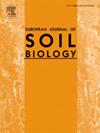Effects of long-term sugarcane-soybean intercropping coupled with varying levels of nitrogen input on soil legacies: A field experimental study
IF 3.3
2区 农林科学
Q1 ECOLOGY
引用次数: 0
Abstract
Long-term agricultural management practices alter the biochemical properties of soil, leading to the formation of distinct soil legacies. Sugarcane-soybean intercropping is recognized as a sustainable and stable agricultural practice, while the application of nitrogen (N) fertilizer is essential for enhancing crop yields. However, research on the effects of long-term sugarcane-soybean intercropping coupled with varying N levels on soil legacies remains limited. Therefore, we selected four treatments in a long-term field experiment: sugarcane monoculture with reduced N application (MSN1), sugarcane monoculture with conventional N application (MSN2), sugarcane-soybean intercropping with reduced N application (SB2N1), and sugarcane-soybean intercropping with conventional N application (SB2N2). The study aims to investigate the effects of soybean intercropping coupled with varying N application levels on soil abiotic (chemical properties) and biotic (microbial communities) legacies. The results showed that under conventional N application (525 kg ha−1), intercropping, compared to monoculture, significantly increased the contents of total potassium (TK), nitrate nitrogen (NO3−), available zinc (AZn) and the network complexity of the arbuscular mycorrhizal fungi (AMF) community. Under intercropping conditions, reduced N application (300 kg ha⁻1), compared to conventional N application, significantly increased the content of exchangeable calcium (ECa), pH, as well as the alpha diversity and network complexity of the bacterial community. Under monocropping conditions, conventional N application significantly increased the complexity of the bacterial community network. Stochastic processes dominated the assembly of bacterial and AMF communities, but under the same cropping pattern, deterministic processes in fungal communities increased with N application. Soil pH, N nutrients, and trace metal elements are key factors affecting the diversity and composition of soil microbial communities. These findings highlight the significant impact of intercropped soybean on soil legacies, whereas the N level of application plays a key role in regulating the effectiveness of biotic and abiotic soil legacies. This study provides valuable insights into managing soil legacies and provides a theoretical basis for the development of sustainable agriculture.

长期甘蔗-大豆间作配施不同氮素水平对土壤遗传的影响:田间试验研究
长期的农业管理实践改变了土壤的生化特性,从而形成了独特的土壤遗产。甘蔗-大豆间作是公认的可持续稳定的农业生产方式,而氮肥的施用是提高作物产量的关键。然而,长期甘蔗-大豆间作配施不同氮水平对土壤遗传影响的研究仍然有限。因此,本研究选择甘蔗单作减氮(MSN1)、甘蔗单作常规施氮(MSN2)、甘蔗-大豆间作减氮(SB2N1)和甘蔗-大豆间作常规施氮(SB2N2) 4个处理进行长期田间试验。本研究旨在探讨大豆间作配施不同施氮量对土壤非生物(化学性质)和生物(微生物群落)遗传的影响。结果表明,在常规施氮(525 kg ha−1)条件下,套作与单作相比,显著提高了丛枝菌根真菌(AMF)群落的总钾(TK)、硝态氮(NO3−)、有效锌(AZn)含量和网络复杂性。间作条件下,与常规施氮相比,减少施氮量(300 kg ha - 1)显著提高了土壤中交换性钙(ECa)含量、pH值以及细菌群落的α多样性和网络复杂性。在单作条件下,常规施氮显著增加了细菌群落网络的复杂性。细菌和AMF群落的聚集以随机过程为主,但在相同种植模式下,真菌群落的聚集随施氮量的增加而增加。土壤pH、N养分和微量金属元素是影响土壤微生物群落多样性和组成的关键因素。这些结果表明间作大豆对土壤遗传的影响显著,而施氮水平在调节生物和非生物土壤遗传的有效性中起关键作用。该研究为土壤遗产管理提供了有价值的见解,并为可持续农业的发展提供了理论依据。
本文章由计算机程序翻译,如有差异,请以英文原文为准。
求助全文
约1分钟内获得全文
求助全文
来源期刊

European Journal of Soil Biology
环境科学-生态学
CiteScore
6.90
自引率
0.00%
发文量
51
审稿时长
27 days
期刊介绍:
The European Journal of Soil Biology covers all aspects of soil biology which deal with microbial and faunal ecology and activity in soils, as well as natural ecosystems or biomes connected to ecological interests: biodiversity, biological conservation, adaptation, impact of global changes on soil biodiversity and ecosystem functioning and effects and fate of pollutants as influenced by soil organisms. Different levels in ecosystem structure are taken into account: individuals, populations, communities and ecosystems themselves. At each level, different disciplinary approaches are welcomed: molecular biology, genetics, ecophysiology, ecology, biogeography and landscape ecology.
 求助内容:
求助内容: 应助结果提醒方式:
应助结果提醒方式:


